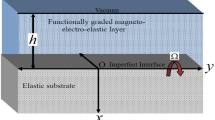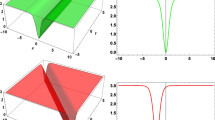Abstract
A closed form solution is given for the problem of simple harmonic plane waves incident obliquely on a semi-infinite barrier. The amplitude of the Kelvin wave component is considered and it is found that increased amplitudes of the Kelvin waves can be expected for certain wave numbers, depending upon the angle of incidence.
Similar content being viewed by others
References
Buchwald, V. T. (1968),The diffraction of Kelvin waves at a corner, J. Fluid Mech.31, 193–205.
Copson, E. T. (1967),Asymptotic Expansions, Cambridge Univ. Press.
Crease, J. (1956),Long waves on a rotating earth in the presence of a semi-infinite barrier, J. Fluid Mech. 1, 80–96.
Noble, B. (1958),Methods Based on the Wiener-Hopf Technique, Oxford, Pergamon.
Packham, B. A. andWilliams, W. E. (1968),Diffraction of Kelvin waves at a sharp bend, J. Fluid Mech.34, 517–529.
Pinsent, H. G. (1971),The effect of a depth discontinuity on Kelvin wave diffraction, J. Fluid Mech.45, 747–758.
Proudman, J. (1953),Dynamical Oceanography, London, Methuen.
Author information
Authors and Affiliations
Rights and permissions
About this article
Cite this article
Haines, C.R. Kelvin wave generation by a semi-infinite barrier. PAGEOPH 119, 46–50 (1980). https://doi.org/10.1007/BF00878720
Received:
Revised:
Issue Date:
DOI: https://doi.org/10.1007/BF00878720




